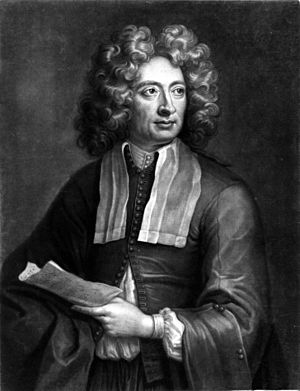Hugh Howard (painter) facts for kids
Hugh Howard (born February 7, 1675 – died March 17, 1737) was a talented artist and a big collector of art. He was born in Dublin, Ireland.
Contents
Hugh Howard's Life Story
Hugh Howard was born in Dublin on February 7, 1675. He was the oldest son of Ralph Howard. In 1688, when he was about 13, he moved to England with his father.
Hugh showed a strong interest in painting. In 1697, he joined a group traveling with Thomas Herbert, the Earl of Pembroke. The Earl was helping to make a peace treaty called the Treaty of Ryswyck. Hugh traveled through Holland and then to Italy with this group.
Studying Art in Italy
Hugh Howard stayed in Italy for about three years. He studied painting with a famous artist named Carlo Maratti. Maratti was known for painting in a style similar to the great artist Raphael.
Hugh returned to the British Isles in October 1700. He lived in Dublin for a while before settling in London. There, he worked as a portrait painter, creating pictures of people.
New Jobs and Royal Society
Later, Hugh Howard got two important jobs that didn't require much painting. He became the "keeper of the state papers" and the "paymaster of the works belonging to the crown." These jobs paid well and allowed him to stop painting professionally. He could then focus on his love for art in new ways.
In November 1696, Hugh was also chosen to be a Fellow of the Royal Society. This is a very old and respected group for important scientists and thinkers.
Hugh Howard: Art Collector
Hugh Howard earned good money from his new jobs, and he also had his own family money. This allowed him to spend a lot on buying amazing works of art. He collected many things, including old coins (medals), drawings, and prints. He even bought items from the collections of other famous art lovers like Sir Peter Lely and the Earl of Arundel.
In 1714, Hugh married Thomasine, who was the daughter of a wealthy general. This also helped him have more money for his art collection.
His Own Art and Legacy
Hugh Howard also created some of his own art. He made a few etchings, which are a type of print. He also made twenty-one drawings, including a picture of Cardinal Albani. Some of his drawings are kept in the British Museum today.
A famous writer named Matthew Prior even wrote a poem to honor Hugh Howard.
Hugh Howard passed away in Pall Mall, London, on March 17, 1737. He was buried in a church in Richmond, Surrey.
In 1728, Hugh inherited part of a large library from his younger brother, William Howard. After Hugh died, he left all his art collections to his only surviving brother, Robert Howard, who was a bishop. Robert had the collections moved to Ireland.
The collections stayed with Robert's family, the Earls of Wicklow, for many years. Then, in December 1873, the fifth Earl of Wicklow sold a large part of the collection. Many of Hugh Howard's prints and drawings, about 1,488 of them, were bought by the British Museum in 1874.



